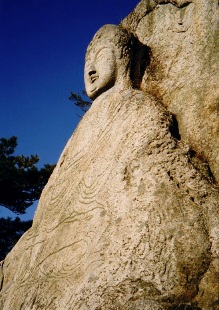Korean Buddhism
Korean Buddhism is the distinct form of Buddhism that has developed in Korea, incorporating a variety of influences from China, Japan, and indigenous Korean culture. It has a history that spans over a millennium, deeply impacting the spiritual, cultural, and social life of Korea.
History[edit | edit source]
The introduction of Buddhism to Korea is traditionally dated to 372 CE, during the Three Kingdoms period. It was initially brought to the Korean peninsula by Chinese monks and quickly adopted by the Goguryeo kingdom. Buddhism in Korea evolved through the subsequent Silla and Goryeo dynasties, where it enjoyed state support and played a significant role in the unification of Korea under the Silla dynasty and in the cultural achievements of the Goryeo dynasty.
During the Joseon Dynasty, Buddhism faced suppression as Confucianism became the state ideology. Many temples were destroyed or forced to relocate to remote areas. Despite this, Buddhism managed to survive and adapt, maintaining its influence among the common people.
In the 20th century, Korean Buddhism underwent a revival, particularly with the modernization efforts and the establishment of Buddhist educational institutions. Today, it continues to play a significant role in South Korean society, with a significant number of followers and temples spread across the country.
Schools of Korean Buddhism[edit | edit source]
Korean Buddhism consists of various schools, with the Seon school being the most prominent. Seon is the Korean equivalent of Zen Buddhism, which emphasizes meditation and direct experience of enlightenment. Other schools include the Jogye Order, which is the largest Buddhist order in Korea and focuses on the Seon practice, and the Taego Order, which allows for married clergy.
Practices and Teachings[edit | edit source]
The practices and teachings of Korean Buddhism are similar to those found in other forms of East Asian Buddhism. They include meditation (Seon), ritual services, chanting of sutras, and veneration of Buddhas and bodhisattvas. Korean Buddhism is also known for its unique practices such as the 108 bows and temple stays, which offer laypeople a chance to experience monastic life.
Cultural Impact[edit | edit source]
Korean Buddhism has had a profound impact on Korean culture, influencing art, literature, and philosophy. Buddhist temples, such as Bulguksa and Seokguram, are considered architectural masterpieces and are designated UNESCO World Heritage Sites. Buddhist festivals, such as Buddha's Birthday, are celebrated nationwide with colorful lantern parades and cultural performances.
Challenges and Contemporary Issues[edit | edit source]
Korean Buddhism faces challenges in the modern era, including secularization, declining monk and nun ordinations, and the need to address social issues. However, it continues to adapt and find relevance in contemporary Korean society through social welfare projects, educational programs, and engagement in interfaith dialogue.
Search WikiMD
Ad.Tired of being Overweight? Try W8MD's physician weight loss program.
Semaglutide (Ozempic / Wegovy and Tirzepatide (Mounjaro / Zepbound) available.
Advertise on WikiMD
|
WikiMD's Wellness Encyclopedia |
| Let Food Be Thy Medicine Medicine Thy Food - Hippocrates |
Translate this page: - East Asian
中文,
日本,
한국어,
South Asian
हिन्दी,
தமிழ்,
తెలుగు,
Urdu,
ಕನ್ನಡ,
Southeast Asian
Indonesian,
Vietnamese,
Thai,
မြန်မာဘာသာ,
বাংলা
European
español,
Deutsch,
français,
Greek,
português do Brasil,
polski,
română,
русский,
Nederlands,
norsk,
svenska,
suomi,
Italian
Middle Eastern & African
عربى,
Turkish,
Persian,
Hebrew,
Afrikaans,
isiZulu,
Kiswahili,
Other
Bulgarian,
Hungarian,
Czech,
Swedish,
മലയാളം,
मराठी,
ਪੰਜਾਬੀ,
ગુજરાતી,
Portuguese,
Ukrainian
Medical Disclaimer: WikiMD is not a substitute for professional medical advice. The information on WikiMD is provided as an information resource only, may be incorrect, outdated or misleading, and is not to be used or relied on for any diagnostic or treatment purposes. Please consult your health care provider before making any healthcare decisions or for guidance about a specific medical condition. WikiMD expressly disclaims responsibility, and shall have no liability, for any damages, loss, injury, or liability whatsoever suffered as a result of your reliance on the information contained in this site. By visiting this site you agree to the foregoing terms and conditions, which may from time to time be changed or supplemented by WikiMD. If you do not agree to the foregoing terms and conditions, you should not enter or use this site. See full disclaimer.
Credits:Most images are courtesy of Wikimedia commons, and templates, categories Wikipedia, licensed under CC BY SA or similar.
Contributors: Prab R. Tumpati, MD





